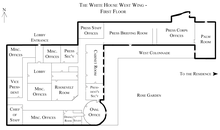The West Wing, also known as the Executive Office Building, houses the offices of the President of the United States. Part of the White House Complex, it contains the Oval Office, the Cabinet Room, the Situation Room, and the Roosevelt Room.
The West Wing's three floors contain offices for the White House Chief of Staff, the Counselor to the President, the Senior Advisor to the President, the White House Press Secretary, and their support staffs. The Vice-President has an office in the building, but his primary office is next-door in the Eisenhower Executive Office Building.
The James S. Brady Press Briefing Room – where the Press Secretary makes announcements and gives daily briefings to reporters – is located in the West Colonnade, between the West Wing and the White House (Executive Residence).
History
Before construction of the West Wing, presidential staff worked on the second floor of what is now the Executive Residence. However, when Theodore Roosevelt became President, he found that the existing offices in the Mansion were insufficient to accommodate his family as well as his staff. In 1902 he had the West Wing constructed by the New York architects McKim, Mead & White. The West Wing was originally intended as a temporary office structure, built on the site of the greenhouse and stables. The President's Office and the Cabinet Room took up the eastern third of the building. President Roosevelt's office was located approximately where the Roosevelt Room is now.
In 1909, William Howard Taft expanded the building southward, covering the tennis court. He placed the first Oval Office at the center of the addition's south facade, reminiscent of the oval rooms of the White House.
President Herbert Hoover rebuilt the West Wing at the beginning of his administration, excavating a partial basement, and supporting it with structural steel. The completed building lasted less than seven months. On December 24, 1929, the West Wing was significantly damaged by an electrical fire.
Hoover rebuilt it, and added air-conditioning.
The fourth and final major reorganization was undertaken by President Franklin D. Roosevelt. Dissatisfied with the size and layout of the West Wing, he engaged New York architect Eric Gugler to redesign it in 1933. To create additional space without increasing the apparent size of the building, Gugler excavated a full basement, added a set of subterranean offices under the adjacent lawn, and built an unobtrusive "penthouse" story. The directive to wring the most office space out of the existing building was responsible for its narrow corridors and cramped staff offices. Gugler's most notable change was the addition to the east side containing a new Cabinet Room, Secretary's Office, and Oval Office. The new office's location gave presidents greater privacy, allowing them to slip back and forth between the White House and the West Wing without being in full view of the staff.

- Original West Wing and tennis court, circa 1903.
As presidential staffs grew substantially in the latter half of the 20th century, the West Wing generally came to be seen as too small for its modern governmental functions. Today, most of the staff members of the Executive Office of the President are located in the adjacent Eisenhower Executive Office Building—originally the State, War, and Navy Building, after the departments it was built to house.
First Floor
Nixon also renamed the room previously called by Franklin Roosevelt the "Fish Room"(where he kept aquariums, and where John F. Kennedy displayed trophy fish) in honor of the two Presidents Roosevelt: Theodore, who first built the West Wing, and Franklin, who built the current Oval Office. By tradition, a portrait of Franklin Roosevelt hangs over the mantel of the Roosevelt Room during the administration of a president from the Democratic Party and a portrait of Theodore Roosevelt hangs during the administration of a Republican president (although President Clinton chose to retain the portrait of Theodore Roosevelt above the mantel). In the past, the portrait not hanging over the mantel hung on the opposite wall. However, during the first term of President George W. Bush's administration, an audio-visual cabinet was placed on the opposite wall providing secure audio and
visual conference capabilities across the hall from the Oval Office.
Press Briefing Room
During the 1930's, the March of Dimes constructed a swimming pool so that FDR could exercise, as therapy for his disability. Richard Nixon had the swimming pool covered over to create the Press Briefing Room, where the White House Press Secretary gives daily briefings.
Ground Floor
Situation Room
White House Mess
The West Wing ground floor is also the site of a cafeteria, staffed by Naval culinary specialists and called the White House Mess. It is located underneath the Oval Office, and was established by President Truman on June 11, 1951.Second Floor
Depiction on The West Wing TV series
In 1999, The West Wing television series brought greater
public attention to the workings of the Presidential staff, as well as
to the location of those working in the West Wing. The show followed the
working lives of a fictional Democratic American President, Josiah
Bartlet, and his senior staff. When asked whether the show accurately
captured the working environment in 2003, Press Secretary Scott McClellan commented that the show portrayed more foot traffic and larger rooms than in the real wing.
External links
- White House Museum: West Wing, with floorplan and historical images
- West Wing Interactive, from National Journal Magazine
- "Tour the West Wing". Retrieved May 25, 2013.
- "The Oval Office". Retrieved May 25, 2013.
- "The President's Cabinet".
- "Situation Room".
- "Roosevelt Room".
- "Inside the White House".







